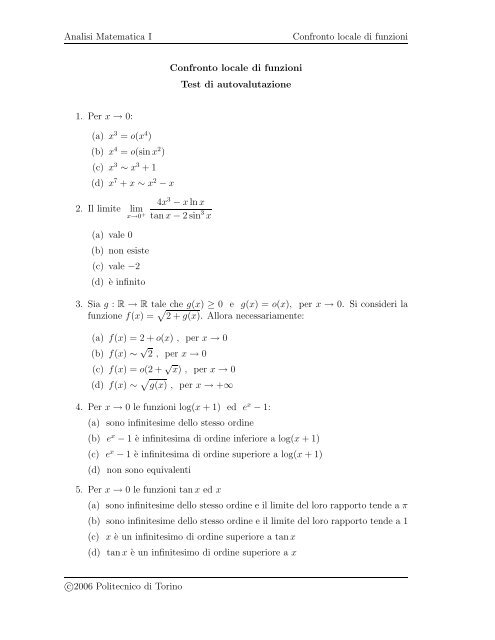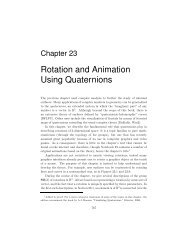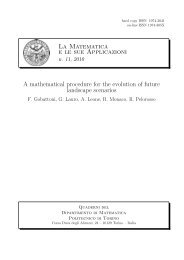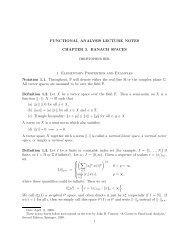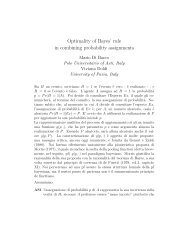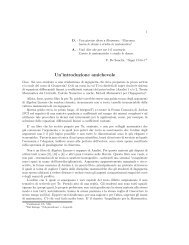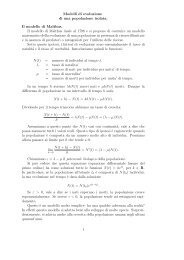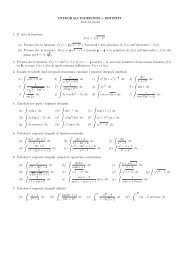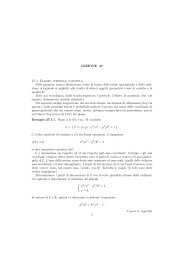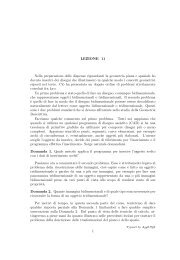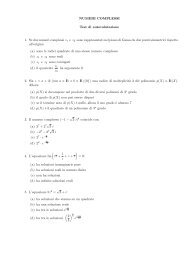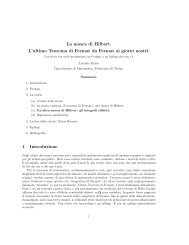Analisi Matematica I Confronto locale di funzioni Confronto locale di ...
Analisi Matematica I Confronto locale di funzioni Confronto locale di ...
Analisi Matematica I Confronto locale di funzioni Confronto locale di ...
You also want an ePaper? Increase the reach of your titles
YUMPU automatically turns print PDFs into web optimized ePapers that Google loves.
<strong>Analisi</strong> <strong>Matematica</strong> I <strong>Confronto</strong> <strong>locale</strong> <strong>di</strong> <strong>funzioni</strong><br />
1. Per x → 0:<br />
(a) x 3 = o(x 4 )<br />
(b) x 4 = o(sin x 2 )<br />
(c) x 3 ∼ x 3 + 1<br />
(d) x 7 + x ∼ x 2 − x<br />
2. Il limite lim<br />
x→0 +<br />
(a) vale 0<br />
(b) non esiste<br />
(c) vale −2<br />
(d) è infinito<br />
<strong>Confronto</strong> <strong>locale</strong> <strong>di</strong> <strong>funzioni</strong><br />
4x 3 − x ln x<br />
tan x − 2 sin 3 x<br />
Test <strong>di</strong> autovalutazione<br />
3. Sia g : R → R tale che g(x) ≥ 0 e g(x) = o(x), per x → 0. Si consideri la<br />
funzione f(x) = 2 + g(x). Allora necessariamente:<br />
(a) f(x) = 2 + o(x) , per x → 0<br />
(b) f(x) ∼ √ 2 , per x → 0<br />
(c) f(x) = o(2 + √ x) , per x → 0<br />
(d) f(x) ∼ g(x) , per x → +∞<br />
4. Per x → 0 le <strong>funzioni</strong> log(x + 1) ed e x − 1:<br />
(a) sono infinitesime dello stesso or<strong>di</strong>ne<br />
(b) e x − 1 è infinitesima <strong>di</strong> or<strong>di</strong>ne inferiore a log(x + 1)<br />
(c) e x − 1 è infinitesima <strong>di</strong> or<strong>di</strong>ne superiore a log(x + 1)<br />
(d) non sono equivalenti<br />
5. Per x → 0 le <strong>funzioni</strong> tan x ed x<br />
(a) sono infinitesime dello stesso or<strong>di</strong>ne e il limite del loro rapporto tende a π<br />
(b) sono infinitesime dello stesso or<strong>di</strong>ne e il limite del loro rapporto tende a 1<br />
(c) x è un infinitesimo <strong>di</strong> or<strong>di</strong>ne superiore a tanx<br />
(d) tanx è un infinitesimo <strong>di</strong> or<strong>di</strong>ne superiore a x<br />
c○2006 Politecnico <strong>di</strong> Torino
<strong>Analisi</strong> <strong>Matematica</strong> I <strong>Confronto</strong> <strong>locale</strong> <strong>di</strong> <strong>funzioni</strong><br />
6. La funzione x2 + 1<br />
x<br />
(a) ha come asintoto la retta y = x<br />
(b) ha come asintoto la retta y = 1<br />
(c) non ha asintoti verticali<br />
(d) ha due <strong>di</strong>stinti asintoti obliqui<br />
7. La funzione 2x2 − 3<br />
2 + x 2<br />
(a) ha come asintoto la retta y = 2x<br />
(b) è infinita <strong>di</strong> or<strong>di</strong>ne 2<br />
(c) presenta un asintoto verticale in x = −2<br />
(d) ha come asintoto la retta y = 2<br />
8. Le <strong>funzioni</strong> sin 1<br />
x<br />
(a) sono equivalenti<br />
e cos 1<br />
x<br />
per x → 0<br />
(b) la prima tende a 0 e la seconda ad 1<br />
(c) tendono entrambe a zero<br />
(d) non ammettono limite<br />
9. La successione an = 3n − 5n<br />
10.<br />
(a) è infinitesima<br />
(b) tende a +∞<br />
(c) tende a −∞<br />
2n :<br />
− n2 (d) non ammette limite per n → ∞<br />
È data la successione<br />
Allora:<br />
(a) la sua parte principale è<br />
(b) è oscillante<br />
an =<br />
1<br />
n √ n<br />
(c) è equivalente alla successione bn = 1<br />
n<br />
(d) è infinita<br />
c○2006 Politecnico <strong>di</strong> Torino<br />
√ n + 1 − √ n − 1<br />
n
<strong>Analisi</strong> <strong>Matematica</strong> I <strong>Confronto</strong> <strong>locale</strong> <strong>di</strong> <strong>funzioni</strong><br />
11. La successione<br />
(a) tende a 1<br />
(b) tende a e −1<br />
(c) è <strong>di</strong>vergente<br />
(d) tende a −e<br />
an =<br />
12. In x = 0 la funzione f(x) = ln(1 + x2 )<br />
3x 2<br />
(a) ha una <strong>di</strong>scontinuità eliminabile<br />
n n<br />
n + 1<br />
(b) ha una <strong>di</strong>scontinuità <strong>di</strong> seconda specie<br />
(c) ha limite infinito<br />
(d) ha un salto<br />
c○2006 Politecnico <strong>di</strong> Torino
<strong>Analisi</strong> <strong>Matematica</strong> I <strong>Confronto</strong> <strong>locale</strong> <strong>di</strong> <strong>funzioni</strong><br />
1. Per x → 0:<br />
(a) x 3 = o(x 4 )<br />
(b) x 4 = o(sin x 2 )<br />
(c) x 3 ∼ x 3 + 1<br />
(d) x 7 + x ∼ x 2 − x<br />
RISPOSTA ESATTA: (b)<br />
La risposta (a) è falsa: infatti lim<br />
x→0<br />
La risposta (b) è vera: infatti lim<br />
x→0<br />
La risposta (c) è falsa: infatti lim<br />
x→0<br />
La risposta (d) è falsa: infatti lim<br />
x→0<br />
c○2006 Politecnico <strong>di</strong> Torino<br />
x 3<br />
= ∞ = 0.<br />
x4 x 4<br />
= lim<br />
sin x2 x→0<br />
x4 = 0.<br />
x2 x3 x3 = 0 = 1.<br />
+ 1<br />
x7 + x<br />
x2 x<br />
= lim<br />
− x x→0 −x<br />
= −1 = 1.
<strong>Analisi</strong> <strong>Matematica</strong> I <strong>Confronto</strong> <strong>locale</strong> <strong>di</strong> <strong>funzioni</strong><br />
2. Il limite lim<br />
x→0 +<br />
(a) vale 0<br />
(b) non esiste<br />
(c) vale −2<br />
(d) è infinito<br />
4x 3 − x ln x<br />
tan x − 2 sin 3 x<br />
RISPOSTA ESATTA: (d)<br />
Per x → 0 + , si ha 4x 3 = o(x ln x) e anche sin 3 x = o(tanx): infatti<br />
Pertanto<br />
lim<br />
x→0 +<br />
4x3 x ln x<br />
lim<br />
x→0 +<br />
= lim<br />
x→0 +<br />
4x2 ln x<br />
4x 3 − x ln x<br />
tan x − 2 sin 3 x<br />
= 0 e lim<br />
x→0 +<br />
sin3 x<br />
tan x<br />
= lim<br />
x→0 +<br />
−x ln x<br />
tanx<br />
= lim<br />
x→0 +<br />
x3 x<br />
= 0 .<br />
= lim<br />
x→0 +(−<br />
ln x) = +∞ ,<br />
cioè quanto asserito in (d); dunque (a), (b) e (c) sono false.<br />
c○2006 Politecnico <strong>di</strong> Torino
<strong>Analisi</strong> <strong>Matematica</strong> I <strong>Confronto</strong> <strong>locale</strong> <strong>di</strong> <strong>funzioni</strong><br />
3. Sia g : R → R tale che g(x) ≥ 0 e g(x) = o(x), per x → 0. Si consideri la<br />
funzione f(x) = 2 + g(x). Allora necessariamente:<br />
(a) f(x) = 2 + o(x) , per x → 0<br />
(b) f(x) ∼ √ 2 , per x → 0<br />
(c) f(x) = o(2 + √ x) , per x → 0<br />
(d) f(x) ∼ g(x) , per x → +∞<br />
RISPOSTA ESATTA: (b)<br />
La risposta (d) è senz’altro da scartare, perché le informazioni date forniscono<br />
in<strong>di</strong>cazioni sul comportamento <strong>di</strong> f(x) e g(x) per x → 0 e non per x → +∞.<br />
Riguardo al comportamento per x → 0, osserviamo preliminarmente che<br />
g(x) = o(x) =⇒ lim<br />
x→0 g(x) = 0 .<br />
Per stu<strong>di</strong>are la risposta (a), calcoliamo<br />
<br />
f(x) − 2 2 + g(x) − 2<br />
lim = lim<br />
= ∞ = 0 ;<br />
x→0 x x→0 x<br />
quin<strong>di</strong> (a) è falsa.<br />
Passiamo alla (b), e calcoliamo<br />
<br />
f(x) 2 + g(x)<br />
lim √2 = lim √ = 1 ;<br />
x→0 x→0 2<br />
dunque (b) è vera.<br />
Infine, calcoliamo<br />
pertanto (c) è falsa.<br />
c○2006 Politecnico <strong>di</strong> Torino<br />
f(x)<br />
lim<br />
x→0 2 + √ x<br />
= lim<br />
x→0<br />
2 + g(x)<br />
2 + √ x =<br />
√<br />
2<br />
= 0 ;<br />
2
<strong>Analisi</strong> <strong>Matematica</strong> I <strong>Confronto</strong> <strong>locale</strong> <strong>di</strong> <strong>funzioni</strong><br />
4. Per x → 0 le <strong>funzioni</strong> log(x + 1) ed e x − 1:<br />
(a) sono infinitesime dello stesso or<strong>di</strong>ne<br />
(b) e x − 1 è infinitesima <strong>di</strong> or<strong>di</strong>ne inferiore a log(x + 1)<br />
(c) e x − 1 è infinitesima <strong>di</strong> or<strong>di</strong>ne superiore a log(x + 1)<br />
(d) non sono equivalenti<br />
RISPOSTA ESATTA: (a)<br />
Per x → 0 si ha log (x + 1) ∼ x e anche e x − 1 ∼ x. Pertanto le due <strong>funzioni</strong><br />
sono equivalenti tra <strong>di</strong> loro e dunque sono infinitesime dello stesso or<strong>di</strong>ne.<br />
c○2006 Politecnico <strong>di</strong> Torino
<strong>Analisi</strong> <strong>Matematica</strong> I <strong>Confronto</strong> <strong>locale</strong> <strong>di</strong> <strong>funzioni</strong><br />
5. Per x → 0 le <strong>funzioni</strong> tan x ed x<br />
(a) sono infinitesime dello stesso or<strong>di</strong>ne e il limite del loro rapporto tende a π<br />
(b) sono infinitesime dello stesso or<strong>di</strong>ne e il limite del loro rapporto tende a 1<br />
(c) x è un infinitesimo <strong>di</strong> or<strong>di</strong>ne superiore a tanx<br />
(d) tanx è un infinitesimo <strong>di</strong> or<strong>di</strong>ne superiore a x<br />
RISPOSTA ESATTA: (b)<br />
sin x<br />
Dal limite fondamentale lim = 1 si ricava<br />
x→0 x<br />
tanx<br />
lim<br />
x→0 x<br />
= lim<br />
x→0<br />
sin x<br />
x<br />
1<br />
cosx<br />
sin x<br />
= lim<br />
x→0 x<br />
= 1 .<br />
Poiché il limite del loro rapporto è un valore finito non nullo, le due <strong>funzioni</strong><br />
sono infinitesime dello stesso or<strong>di</strong>ne.<br />
c○2006 Politecnico <strong>di</strong> Torino
<strong>Analisi</strong> <strong>Matematica</strong> I <strong>Confronto</strong> <strong>locale</strong> <strong>di</strong> <strong>funzioni</strong><br />
6. La funzione x2 + 1<br />
x<br />
(a) ha come asintoto la retta y = x<br />
(b) ha come asintoto la retta y = 1<br />
(c) non ha asintoti verticali<br />
(d) ha due <strong>di</strong>stinti asintoti obliqui<br />
RISPOSTA ESATTA: (a).<br />
La funzione f(x) = x2 + 1<br />
presenta un asintoto verticale (la retta x = 0);<br />
x<br />
pertanto la risposta (c) è falsa.<br />
x<br />
Poiché lim<br />
x→±∞<br />
2 + 1<br />
= ±∞, la funzione non ha asintoti orizzontali; dunque la<br />
x<br />
risposta (b) è falsa.<br />
Si ha invece<br />
f(x)<br />
lim<br />
x→±∞ x<br />
= 1 e lim (f(x) − x) = 0 .<br />
x→±∞<br />
Pertanto la retta y = x è l’unico asintoto obliquo <strong>di</strong> f(x).<br />
c○2006 Politecnico <strong>di</strong> Torino
<strong>Analisi</strong> <strong>Matematica</strong> I <strong>Confronto</strong> <strong>locale</strong> <strong>di</strong> <strong>funzioni</strong><br />
7. La funzione 2x2 − 3<br />
2 + x 2<br />
(a) ha come asintoto la retta y = 2x<br />
(b) è infinita <strong>di</strong> or<strong>di</strong>ne 2<br />
(c) presenta un asintoto verticale in x = −2<br />
(d) ha come asintoto la retta y = 2<br />
RISPOSTA ESATTA: (d)<br />
La funzione non ha asintoti verticali, perché il denominatore non si annulla e<br />
il dominio è tutto R.<br />
Poiché lim f(x) = 2, la funzione ammette la retta y = 2 come asintoto<br />
x→±∞<br />
orizzontale completo. Dunque non può avere asintoti obliqui, e non è infinita,<br />
per nessun valore <strong>di</strong> x ∈ R.<br />
c○2006 Politecnico <strong>di</strong> Torino
<strong>Analisi</strong> <strong>Matematica</strong> I <strong>Confronto</strong> <strong>locale</strong> <strong>di</strong> <strong>funzioni</strong><br />
8. Le <strong>funzioni</strong> sin 1<br />
x<br />
(a) sono equivalenti<br />
e cos 1<br />
x<br />
per x → 0<br />
(b) la prima tende a 0 e la seconda ad 1<br />
(c) tendono entrambe a zero<br />
(d) non ammettono limite<br />
RISPOSTA ESATTA: (d)<br />
I due limiti non esistono. Infatti lim<br />
x→0 ±<br />
1<br />
x<br />
= ±∞ e non esistono i limiti<br />
lim sin t<br />
t→±∞<br />
e lim<br />
t→±∞ cost.<br />
Le due <strong>funzioni</strong> non sono equivalenti, in quanto non esiste il limite del loro<br />
rapporto<br />
c○2006 Politecnico <strong>di</strong> Torino<br />
lim<br />
x→0 ±<br />
sin 1<br />
x<br />
cos 1<br />
x<br />
1<br />
= lim tan<br />
x→0 ± x<br />
= lim<br />
t→±∞ tant.
<strong>Analisi</strong> <strong>Matematica</strong> I <strong>Confronto</strong> <strong>locale</strong> <strong>di</strong> <strong>funzioni</strong><br />
9. La successione an = 3n − 5n<br />
(a) è infinitesima<br />
(b) tende a +∞<br />
(c) tende a −∞<br />
2n :<br />
− n2 (d) non ammette limite per n → ∞<br />
RISPOSTA ESATTA: (b)<br />
Infatti per n → ∞ si ha<br />
Dunque<br />
c○2006 Politecnico <strong>di</strong> Torino<br />
an = 3n − 5n<br />
2n 3n<br />
∼<br />
− n2 2<br />
lim<br />
n→∞ an = lim<br />
n→∞<br />
n =<br />
n 3<br />
2<br />
n 3<br />
= +∞ .<br />
2<br />
.
<strong>Analisi</strong> <strong>Matematica</strong> I <strong>Confronto</strong> <strong>locale</strong> <strong>di</strong> <strong>funzioni</strong><br />
10.<br />
È data la successione<br />
Allora:<br />
(a) la sua parte principale è<br />
(b) è oscillante<br />
an =<br />
1<br />
n √ n<br />
(c) è equivalente alla successione bn = 1<br />
n<br />
(d) è infinita<br />
RISPOSTA ESATTA: (a)<br />
√ n + 1 − √ n − 1<br />
Razionalizzando e tenendo conto che, per n → ∞, √ n + 1 ∼ √ n − 1 ∼ √ n,<br />
si ha √ √<br />
n + 1 − n − 1 2<br />
an =<br />
=<br />
n n( √ n + 1 + √ 1<br />
∼<br />
n − 1) n √ n .<br />
Dunque (a) è vera mentre (c) è falsa.<br />
Inoltre si ha<br />
lim<br />
n→∞ an = lim<br />
n→∞<br />
e quin<strong>di</strong> (b) e (d) sono false.<br />
c○2006 Politecnico <strong>di</strong> Torino<br />
n<br />
√ n + 1 − √ n − 1<br />
n<br />
1<br />
= lim<br />
n→∞ n √ n<br />
= 0 ,
<strong>Analisi</strong> <strong>Matematica</strong> I <strong>Confronto</strong> <strong>locale</strong> <strong>di</strong> <strong>funzioni</strong><br />
11. La successione<br />
(a) tende a 1<br />
(b) tende a e −1<br />
(c) è <strong>di</strong>vergente<br />
(d) tende a −e<br />
RISPOSTA ESATTA: (b)<br />
Infatti:<br />
an =<br />
e dunque lim<br />
n→∞ an = 1<br />
e .<br />
c○2006 Politecnico <strong>di</strong> Torino<br />
an =<br />
n n<br />
n + 1<br />
n n n 1<br />
= n+1 =<br />
n + 1 n<br />
1<br />
1 + 1<br />
n<br />
n
<strong>Analisi</strong> <strong>Matematica</strong> I <strong>Confronto</strong> <strong>locale</strong> <strong>di</strong> <strong>funzioni</strong><br />
12. In x = 0 la funzione f(x) = ln(1 + x2 )<br />
3x 2<br />
(a) ha una <strong>di</strong>scontinuità eliminabile<br />
(b) ha una <strong>di</strong>scontinuità <strong>di</strong> seconda specie<br />
(c) ha limite infinito<br />
(d) ha un salto<br />
RISPOSTA ESATTA: (a)<br />
Per x → 0, si ha ln(1 + x 2 ) ∼ x 2 e pertanto<br />
lim<br />
x→0<br />
ln(1 + x 2 )<br />
3x 2<br />
= lim<br />
x→0<br />
x 2<br />
− 3 2<br />
x<br />
= 1<br />
3 ;<br />
dunque in x = 0 la funzione f(x) = ln(1 + x2 )<br />
3x2 ha una <strong>di</strong>scontinuità eliminabile.<br />
c○2006 Politecnico <strong>di</strong> Torino


